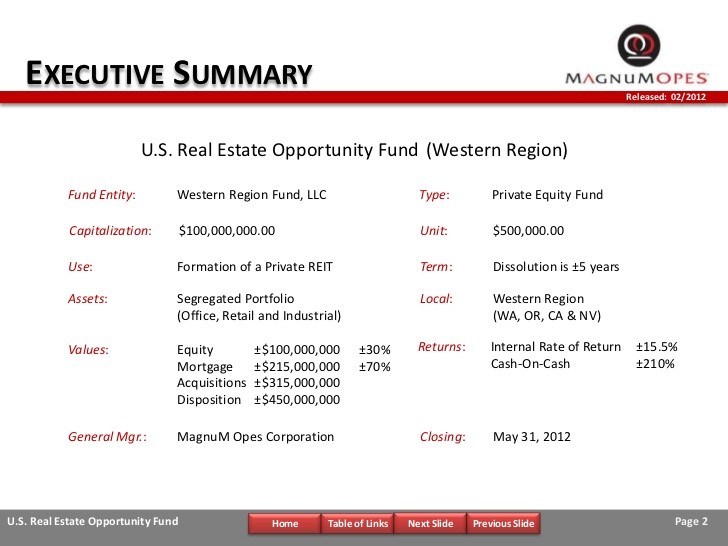A Primer on Real Estate Private Equity Fund Formation and Operations Part I
Post on: 17 Июнь, 2015 No Comment

By Scott A. Fisher, Arnall Golden Gregory LLP and Matthew T. Harris, Arnall Golden Gregory LLP
Past experience may not have saved real estate professionals from the impact of the recent economic downturn, but past experience certainly has real estate professionals looking for the inevitable rebound and recovery of the real estate market. For most, in order to be in a position to take advantage of a market rebound, they are going to need to raise new equity capital.
To raise that capital, many real estate professionals are going to sponsor “real estate funds.” While real estate funds are nothing new and have been a driving force in the real estate market since the 1990’s, this downturn appears to be motivating many real estate professionals who traditionally did not need to raise capital, or did so on a one-off basis, to form and sponsor real estate funds. This article is directed to those real estate professionals who are contemplating forming and sponsoring a real estate fund, but want to more fully understand what that entails.
Preliminary considerations
Before starting down the long, costly and time consuming path of forming and sponsoring a real estate fund, the real estate professional should consider some very basic preliminary issues. Most notably, the real estate professional should consider the following:
Capital Requirements First and foremost, the real estate professional should estimate the minimum amount of capital that he or she will need to raise to have a viable fund and whether, realistically, he or she has the contacts and relationships to attract that amount of capital.
Time, Effort and Monetary Commitment Another critical preliminary issue for the real estate professional is to evaluate whether he or she is prepared to commit the time, effort and money necessary to raise capital for the fund. Marketing the fund to investors requires many meetings with, and presentations to, prospective investors and gatekeepers to pools of investors.
The sponsors of a fund should recognize that the expenses of conducting an offering are not insubstantial, and include legal fees, accounting fees, printing expenses and travel expenses. The sponsors typically advance the start up costs and are reimbursed once capital is raised. For a sponsor’s first fund, these expenses may run towards the mid to high five figures. The actual cost depends upon the sophistication of the sponsor and its ability to define the terms of the deal and provide legal counsel with the materials necessary to prepare the offering documents. The cost is also tied to the number of and specific states in which the offering will be marketed.
Investment strategy
There are several basic components to the characterization of a fund’s investment strategy and objectives. These include identification of targeted investment opportunities by real estate asset classes (e.g.. office, industrial, retail, hotel and other real estate investment categories), method of investing (e.g.. equity, debt or some combination), and investment strategies.
The expression of the fund’s investment strategy and objectives may also include other fundamental terms such as the targeted internal rate of return for prospective investments, leverage ratios, leverage restrictions, level of diversification, a time schedule within which the fund will deploy investment capital, and a time schedule within which to liquidate those investments and complete distributions of realized proceeds to fund investors.
Prior performance and sponsor compensation
Another important preliminary factor to consider when getting started is the extent to which sponsors will market a proposed fund by reference to the operating history or prior performance of the fund sponsor. Because investors in real estate funds generally qualify as accredited investors, there is no requirement for a sponsor to disclose prior performance (although the securities laws “materiality” requirements may suggest that a sponsor at least disclose its negative performance). It may, however, be unrealistic for a sponsor to expect to raise a significant amount of capital without an extensive table of past deals, which includes the good, the bad and the ugly.
For purposes of determining sponsor compensation, it is worth noting that the economic structure of a fund, especially the pooling of multiple investments, may effectively defer the sponsor’s participation in the upside of profitable transactions or subject the sponsor’s distributions received to clawback provisions until the assets are sold and the fund is liquidated. Because real estate professionals typically realize profits on a deal by deal basis, the sponsor must carefully consider what compensation (i.e.. fees) it may require in order to fund its overhead until it is able to realize the upside of profitable transactions. Sponsor fees, which are generally carefully reviewed by investors, may include management fees, acquisition fees, construction fees and other fees.
Securities laws, the private placement memorandum and the use of broker-dealers
Compliance with applicable securities laws requires consultation with expert securities professionals and careful monitoring of the manner in which the sponsor conducts the fund’s offering and carries on the fund’s business. Violations of securities laws (or colorable claims that violations occurred) may give unhappy investors the leverage to demand a return of their investment plus interest (known commonly as the right to rescission), not only from the fund, but potentially also from the fund’s sponsors.
Securities laws
Typically, because the alternative (i.e.. an offering registered under state and federal securities law) is cost prohibitive, most real estate fund offerings will seek to qualify as a “private placement” pursuant to an exemption from the requirement to register the offering under the rules of Regulation D of the Securities Act of 1933 and under applicable state securities laws. Basic requirements for the private placement exemption include:
Private Placement. The offering must be conducted as a private placement, meaning that the fund engages in no general solicitation and no advertising, and that the fund offers the investment only to persons with whom the sponsor has a pre-existing substantive relationship.
Accredited Investors. The sponsor must reasonably believe that all investors are “accredited” investors under Regulation D of the Securities Act of 1933. (While technically unaccredited investors may invest in a private placement, other complex requirements to comply with the “private placement” exemption would be triggered if that occurred. Additionally, the legal fees associated with drafting an offering to include unaccredited investors may outweigh the benefit of receiving funds from the unaccredited investors.) Accredited investors are defined as individuals having a net worth of at least $1 million or a regular annual income of at least $200,000 ($300,000 when combined with spouse), business organizations which have total assets of at least $5 million and other less common qualifications involving trusts, benefit plans and executive officers and directors of the fund. Current legislation under consideration may make these standards more stringent.

Blue Sky Filings. The fund must comply with the applicable laws of each of the states in which the fund’s investors reside.
Regardless of whether a fund offering is exempt from registration requirements pursuant to securities laws, applicable federal and state securities laws prohibit both the making of any untrue statement of a material fact and the omission of any material fact that is necessary in order to make the statements made not misleading.
Pre-offering materials and the private placement memorandum
Prior to the acceptance of subscriptions for investments from prospective investors, the sponsor and legal counsel typically prepare a private placement memorandum (the “PPM”) describing the investment opportunity and the risks of the investment. While the substance of the PPM may vary significantly from fund to fund, the scope and structure of PPMs generally follow similar formats. The cost of preparing a PPM will depend upon the complexity of the transaction and the ability of the promoters to provide detailed information about the offering to their counsel. One tool which may be used to manage the offering expense is to test the market through a pre-offering process.
There is nothing unlawful about pre-offering activity provided it complies with certain requirements. The key issues in this pre-offering activity are that the sponsor neither requests nor receives any binding commitment to invest, and that the pre-offering marketing activity is conducted in compliance with the requirements for conducting a “private placement” described above. For practical reasons, it is almost always advisable to limit the scope of pre-offering materials to a limited number of investment considerations and to keep the content of the materials simple.
Use of broker-dealers
Sponsors of real estate funds may need to use or consider using third parties to help them raise capital, which is particularly true in real estate cycles following recessions and other economic downturns. The use of third parties (i.e.. persons who are not the initial sponsors of the real estate fund) raises a number of securities issues. Securities laws generally prohibit issuers from compensating persons for referring or procuring potential investors unless those persons are appropriately qualified and registered as broker-dealers under applicable federal and state laws.
Compensating unregistered finders in violation of these requirements can result in the offering failing to qualify for exemptions from applicable registration requirements, which, along with other violations of securities laws, can result in investors seeking a refund of their investment. Unwary promoters and sponsors may not realize that compensating a friend for referring an investor is a violation of applicable securities laws unless that friend is a registered broker-dealer.
Broker-dealers typically charge a fee of three to eight percent or more of the funds they raise (and potentially all funds raised by the fund). This compensation to broker-dealers may make the investment less attractive to prospective investors by reducing the amount of capital available to be invested by the fund and the ultimate return on the investor’s investment.














